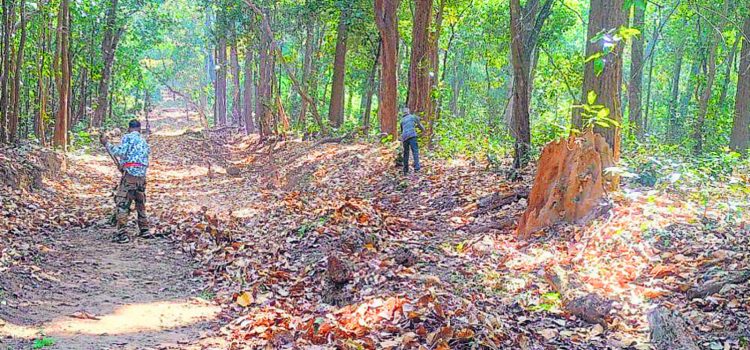
The Uttarakhand forest department has begun reviving British-era firelines to prevent wildfires after receiving clearance from the Supreme Court, which had restricted tree felling above 1,000 metres altitude in a 1996 order.
{{/userSubscribed}}
{{/userSubscribed}}
Decades without tree felling or clearance of vegetation rendered these firelines ineffective, as they have become overgrown with dense vegetation that fails to halt spreading fires.
{{^usCountry}} {{/usCountry}}
Also Read: CM clears Gargai water project for Mumbai amid forest dept opposition
Firelines are strategically cleared strips of land in forests that serve as barriers against wildfire spread. These strips, devoid of vegetation and flammable materials, help slow or stop fires from advancing across forested areas. According to officials, they were initially established during the British colonial period as part of their forest management strategy.
Also Read: 1.7 lakh hectares of forest area diverted for non-forestry purpose in 9 yrs: Govt
“Firelines are an integral part of our forest management and are crucial for forest protection from fires,” said Dhananjai Mohan, head of Uttarakhand forest force. “These firelines were originally established during the British period, but in the 1980s, the government decided to prohibit tree felling above 1,000 metres. Over time, trees and vegetation naturally grew over these fire lines, rendering them ineffective.”
{{/userSubscribed}}
{{/userSubscribed}}
Mohan explained that the ban remained in place following the Supreme Court’s ruling in the TN Godavarman Thirumalpad vs Union of India case. “The state government approached the Supreme Court, emphasising the necessity of reviving fire lines, and we were granted permission.”
{{/usCountry}}
Mohan explained that the ban remained in place following the Supreme Court’s ruling in the TN Godavarman Thirumalpad vs Union of India case. “The state government approached the Supreme Court, emphasising the necessity of reviving fire lines, and we were granted permission.”
{{/usCountry}}
{{/usCountry}}
Also Read: U.P. CM for steps to combat heatwave: Fire control rooms set up in all divisional forests
On May 17,2023, the Supreme Court allowed the state government’s prayer to maintain firelines in the forest areas of Uttarakhand even if it ordains felling of green trees. It also permitted the state government to carry out silviculture operations including felling, thinning, pollarding and other cultural operations in accordance with the prescriptions of working plans approved by the Ministry of Environment, Forest and Climate Change.
{{/userSubscribed}}
{{/userSubscribed}}
But the tracts may not be restored in time for this year’s wildfire season, which typically coincides with the peak summer phase, before the onset of monsoon.
“Work has now begun on clearing 400 kilometres of firelines, and over the next two years, we aim to clear the backlog of the past 40 years. Once completed, managing these fire lines will become significantly easier. They will play a vital role in preventing the spread of forest fires,” he added.
Nishant Verma, additional principal chief conservator of forests and state nodal officer for forest fires, said: “I can’t tell how many trees are to be felled for revival of these firelines, but it is being carried out by the forest corporation as prescribed in the working plan.”
{{/userSubscribed}}
{{/userSubscribed}}
Mohan revealed that the department has developed a four-pronged innovative strategy to prevent forest fires. This includes a mobile app and dashboard to reduce response time, collection of chir pine needles for biofuel production, a memorandum of understanding with the India Meteorological Department for real-time weather analysis, and the adoption of the Shitalakhet forest fire prevention model.
The Shitalakhet model originated in the early 2000s in Shitalakhet, a village in Uttarakhand’s Almora district, as a community-led initiative to combat escalating forest fires and water scarcity. In 2003-2004, the Kosi River, vital for Almora, experienced a drastic reduction in water flow, highlighting the urgent need for environmental intervention.
A group of local youths formed the Shyahi Devi Vikas Manch to address these challenges. They identified that uncontrolled exploitation of broad-leaf trees and frequent forest fires were degrading the forests, leading to diminished water sources.
{{/userSubscribed}}
{{/userSubscribed}}
“From December 15 to February 15, we sent 1,170 personnel from 19 forest divisions to study the model and adopt it in their respective divisions,” said Mohan.
Significant reduction in fire incidents
“Since November 1 last year, only 31 forest fire incidents have been reported in Uttarakhand. This is less than half of the fire incidents recorded during the same period last year,” he said. The fire alerts received during this period from Forest Survey of India have also reduced significantly, from 3,084 to 1,347.
In 2024, 1,276 wildlife incidents were reported in the state that claimed 13 lives, the deadliest toll since 2021 when eight people lost their lives. In June last year, six forest workers were killed while extinguishing a fire at the Binsar Wildlife Sanctuary under the Civil Soyam Forest Division in the Almora district.
{{/userSubscribed}}
{{/userSubscribed}}
According to the biennial India State of Forest Report published by the Forest Survey of India in its 2023 report, released in December last year, Uttarakhand reported 21,033 forest fires from November 2023 to June 2024, the highest number recorded by any state in the country. This represents almost a four-fold increase compared to the corresponding period in the previous year (November 2022 to June 2023).
Forest fires are generally reported from February to June, typically peaking in May and June. The fires impact biodiversity, affecting microorganisms in the soil, wildlife, small insects, birds and people living in and around the forests, disrupting the overall ecology of an area.
In Uttarakhand, 0.10% of total forest cover comes under the extremely fire-prone category, 12.92% under very highly fire-prone, 27.64% under highly fire-prone, 20.01% under moderately fire-prone and 39.33% under less fire-prone category.
{{/userSubscribed}}
{{/userSubscribed}}











